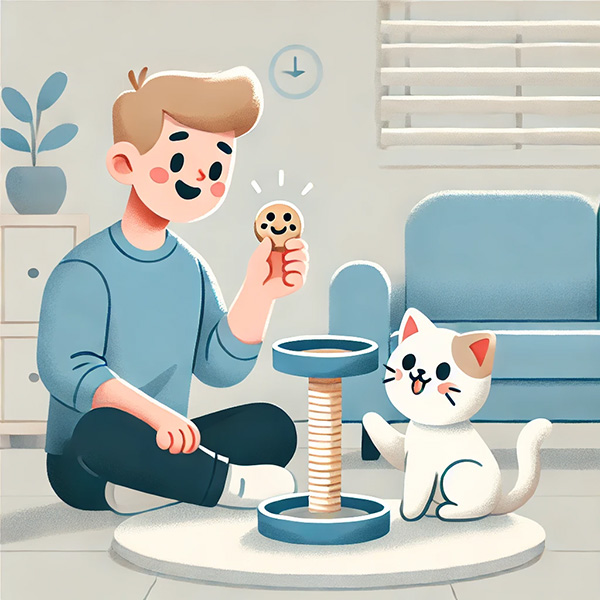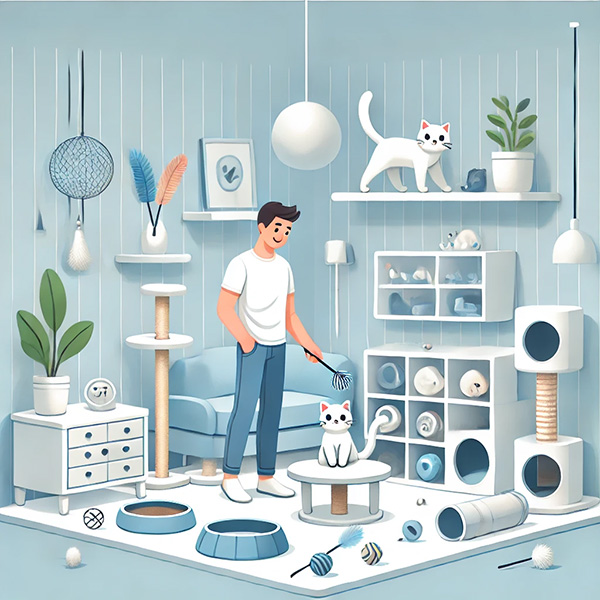Cats have an instinctive tendency to scratch, which is vital in their behavior. This scratching helps them mark their territory, keep their nails healthy, and stretch their muscles. However, it can become a source of frustration for pet owners when cats choose to scratch furniture.
Recognizing why cats scratch furniture is crucial before contemplating declawing as a solution. This guide will explore common issues and provide practical tips to stop cats from scratching your beloved couch and other furniture.
Understand Why Cat Scratching Furniture
Marking Territory
Cat scratching is a natural behavior that meets felines' physical and psychological needs. It's not just about sharpening claws; cat scratching also serves as a way for most cats to leave visual cues and scent marks from glands in their paws. These scents and scratch marks signal their presence to other cats, helping establish territory within their environment. This natural behavior is particularly significant for indoor cats, as they may lack the same opportunities to mark their territory as outdoor cats.
Maintaining Claw Health
Cats must maintain their claws to ensure they stay sharp and healthy. Scratching helps remove the outer sheath of dead claw material, revealing a new, sharper claw underneath. If cats don’t scratch regularly, their claws can become overgrown or brittle, potentially causing discomfort or injury. Scratching helps cats keep their claws healthy and functional.
Stretching and Exercise
Scratching enables cats to stretch their muscles, especially in their front legs and spine. This activity serves as a form of exercise that helps them stay flexible and fit. Extending their legs and digging their claws into a surface provides a satisfying stretch that they instinctively seek throughout the day. Furniture, especially tall items like couches or chairs, provides a sturdy surface.
Stress or Anxiety Relief
Scratching can be a self-soothing behavior for cats, helping them relieve stress or anxiety. Cats that are anxious or unsettled, whether due to changes in their environment, placement of litter boxes, new pets, or even boredom, may scratch more frequently as a way to cope. Furniture scratching may increase in times of stress because cats are using it as a way to feel more secure in their territory.
Boredom or Lack of Stimulation
When a cat lacks physical or mental stimulation and feels bored, it may resort to scratching furniture to express frustration or release excess energy. To prevent destructive behaviors, cats need plenty of engagement, including playtime, toys, a cat tree, and vertical cat shelves for exploration. Scratching can become a way for them to entertain themselves if they don’t have enough other outlets for their energy.
Grooming Behavior
In addition to keeping their claws sharp, cats scratch to clean and groom their paws. Scratching helps them shed dead layers of skin and nail sheaths. It’s part of their overall grooming routine, like licking fur. Regular scratching ensures their claws stay clean, sharp, and functional for activities like climbing and hunting.
Attention-Seeking
At times, cats scratch furniture to seek attention from their owners. If a cat notices that scratching results in immediate attention—whether positive (like being picked up) or negative (such as being scolded)—they may repeat the behavior to get noticed. Even if the attention is negative, some cats prefer it to be ignored, reinforcing the scratching behavior.
Habit and Routine
Scratching is a deeply ingrained behavior that cats perform out of habit. Even if they are provided with appropriate outlets like scratching posts, some cats may continue to scratch furniture simply because it has become part of their routine. Cats often return to the same spots they’ve scratched before, especially if they have marked it as their territory.
Instinctive Behavior
Scratching is an instinct that dates back to wild cats. In their natural environment, cats scratch trees and other surfaces to mark their territory, stretch their muscles, and keep their claws in good condition. Domesticated cats still have these primal instincts, and they naturally seek out surfaces to scratch, even if they don’t need to defend territory or hunt. Furniture often becomes a stand-in for the trees and natural surfaces they would use in the wild.
Exploring Textures
Cats enjoy the sensation of different textures under their paws and claws. Furniture often provides an interesting texture that’s satisfying for cats to scratch. For example, certain fabrics, like leather, linen, or woven materials, may feel especially good to scratch due to their resistance or smoothness. If a cat finds a texture they enjoy, they are likely to return to it repeatedly.
Lack of Proper Scratching Posts
When cats don’t have suitable scratching posts or surfaces, they often turn to furniture as an alternative. Cats need multiple scratching options, such as posts made from sisal, cardboard, or wood, to satisfy their scratching needs. Without these alternatives, they will naturally turn to furniture, carpet, or curtains as an outlet for their scratching behavior.
How to keep cats from scratching furniture
Provide Appropriate Scratching Alternatives

One of the best strategies for preventing cats from scratching furniture is offering suitable alternatives. Scratching posts, cat trees, and horizontal scratching pads are vital to a cat-friendly home. These surfaces support a cat's instincts while safeguarding your furniture.
There are various types of scratching posts to choose from, including those made from sisal rope, corrugated cardboard, and wood. Pay attention to your cat's preferred textures to help you choose the most suitable scratching post.
Position scratching posts in locations where your cat tends to scratch. If your cat scratches furniture in the living room, placing a sturdy base scratching post nearby can entice them to use it instead. The secret is to offer various scratching surfaces to meet your cat's claws' needs.
Place Scratching Posts Near Problem Areas
Careful positioning of scratching posts is essential for encouraging your cat to use them. Cats often scratch in high-traffic areas or near furniture they frequent, so placing scratching posts in these locations is essential.
For example, if your cat scratches the armrest of your couch, position a scratching post nearby. Since cats often scratch upon waking, placing a post near their preferred napping area can promote its use. Positioning posts in social areas of your home can also cater to your cat's need for attention and interaction.
Training Your Cat to Use Scratching Posts

Introducing a new scratching post to your cat takes patience and positive reinforcement. You can begin by positioning the post in an area where your cat often scratches. To encourage exploration, sprinkle some catnip on it or attach toys to catch their interest.
Positive reinforcement, like treats and praise, can strengthen this behavior when your cat uses the scratching post. Engage your cat in play near the post to further entice them. Eventually, your cat will link the scratching post with enjoyment and fulfillment, decreasing the chances of them scratching furniture.
If your cat is hesitant to use the new scratching post, consider using double-sided sticky tape or aluminum foil on furniture as a temporary deterrent. These textures are unpleasant for cats, making the scratching post a more appealing option.
Deterring Furniture Scratching
Various strategies can be employed to discourage cats from scratching furniture. One effective approach is using double-sided tape, which makes the surface sticky and unappealing to scratch. You can also apply specially formulated sprays that deter cats from furniture while remaining safe.
Using furniture guards and protective covers can help prevent damage as you train your cat to use scratching posts. These transparent guards preserve the aesthetic of your furniture while safeguarding it from claw marks.
Temporary deterrents, such as aluminum foil or plastic coverings, can be effective when combined with training. However, consistency and persistence are key. It's essential to provide attractive alternatives like scratching posts while consistently deterring furniture scratching.
Trim Your Cat’s Nails Regularly

Routine nail trimming is another essential factor in managing your cat's scratching habits. By keeping your cat's nails short, you can minimize the damage inflicted on furniture. Trimming their nails every few weeks can considerably reduce the effects of scratching.
If you're uncertain about how to safely trim your cat's nails, it's best to reach out to your veterinarian or a professional groomer. They can show you the correct technique to prevent cutting too close to the quick, which can lead to pain and bleeding.
Use of Nail Caps
Nail caps are a widely used option for cat owners who want to protect their furniture from scratching. These small, soft covers fit over your cat’s nails, making it difficult for them to cause damage while scratching. Nail caps are available in various sizes and colors, typically lasting for several weeks before needing replacement.
Although nail caps can be useful, they need to be maintained on a regular basis. Monitor your cat's nails to ensure the caps remain securely in place, and replace them as needed. Some cats may resist wearing nail caps, so it’s crucial to consider your cat’s comfort and preferences.
Positive Reinforcement

Positive reinforcement training is a highly effective method. Whenever your cat uses its scratching post or pad instead of the furniture, reward it with treats, praise, or extra playtime. You can enhance the appeal of the scratching post by adding a sprinkle of catnip. This approach encourages your cat to associate scratching posts with rewards, which can shift their behavior away from furniture scratching.
Use Pheromone Products
Cats often scratch furniture due to stress or marking behavior. Feline pheromone products, including sprays and diffusers like Feliway, replicate the natural scent markers cats release. These products help create a calming environment for your cat, which may reduce anxiety-induced scratching. Applying a pheromone spray to areas your cat frequently scratches can help them feel more secure, reducing the need to mark territory with scratching.
Redirect the Behavior
If your cat scratches the furniture, calmly guide it towards a scratching post or pad. It's important not to yell or punish your cat, as this may increase anxiety and result in more destructive actions. Instead, move it to the scratching post and encourage it to scratch, placing its paws on it or using a toy to attract it. This teaches your cat that scratching posts are acceptable while furniture is off-limits.
Keep Cats Entertained

Cats may scratch furniture out of boredom or frustration, so it is key to ensure they have enough mental and physical stimulation. Regular playtime with interactive toys, puzzles, and climbing furniture can keep your cat engaged and happy, reducing their need to scratch inappropriately. Providing a variety of toys and activities will help satisfy your cat’s natural instincts for hunting and play, leading to less destructive behavior.
